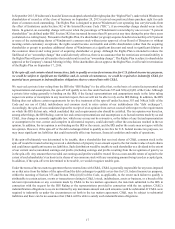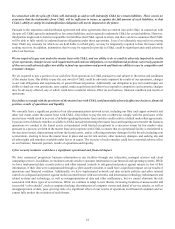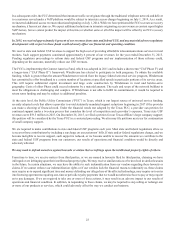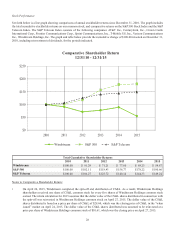Windstream 2015 Annual Report Download - page 105
Download and view the complete annual report
Please find page 105 of the 2015 Windstream annual report below. You can navigate through the pages in the report by either clicking on the pages listed below, or by using the keyword search tool below to find specific information within the annual report.
23
In a subsequent order, the FCC determined that intrastate traffic we originate through the traditional telephone network and deliver
to a customer served under a VoIP platform would be subject to interstate access charges beginning on July 1, 2014. As a result,
we incurred additional access revenue reductions beginning on July 1, 2014. While we have petitioned the FCC to create a recovery
mechanism, it has not yet done so. We expect additional reductions in intrastate originating access revenue as carriers report higher
VoIP factors, but we cannot predict the impact at this time or whether some or all of the impact will be offset by an FCC recovery
mechanism.
In 2015, we received approximately 6 percent of our revenues from state and federal USF, and any material adverse regulatory
developments with respect to these funds could adversely affect our financial and operating condition.
We receive state and federal USF revenues to support the high cost of providing affordable telecommunications services in rural
markets. Such support payments constituted approximately 6 percent of our revenues for the year ended December 31, 2015.
Pending regulatory proceedings to reform state and federal USF programs and our implementation of those reforms could,
depending on the outcome, materially reduce our USF revenues.
The FCC is implementing the Connect America Fund, which was adopted in 2011 and includes a short-term (“CAF Phase I”) and
a longer-term (“CAF Phase II”) framework. Windstream has elected to participate in both programs. To obtain the available
funding, which is greater than the amount Windstream received from the legacy federal universal service program, Windstream
has committed to offer broadband to a certain number of locations at specified speeds in particular portions of its service areas.
This will require substantial capital investment and large scale construction by Windstream in rural and hard-to-serve
geography. Costs of either Phase could exceed estimates by a material amount. The scale and scope of the network buildout to
meet the obligations is challenging and complex. If Windstream is not able to fulfill its commitments, it would be required to
return some funding and may be subject to additional penalties.
At the state level, the Public Utility Commission (“PUC”) in Texas, which is our largest source of universal service funding,
recently adopted a rule that allows a provider to avoid statutorily mandated support reductions beginning in 2017 if the provider
can make a showing of financial need. Under the financial needs test adopted by the Texas PUC, a provider can petition for
continued support under a two-step process that considers the level of competition and a provider’s expenses. Texas state USF
revenues were $59.5 million in 2015. On December 28, 2015, we filed a petition for our Texas affiliate’s large company support;
this petition will be considered by the Texas PUC in a contested proceeding. We also may file petitions next year for continuation
of small company support.
We are required to make contributions to state and federal USF programs each year. Most state and federal regulations allow us
to recover these contributions by including a surcharge on our customers’ bills. If state and/or federal regulations change, and we
become ineligible to receive support, such support is reduced, or we become unable to recover the amounts we contribute to the
state and federal USF programs from our customers, our results of operations and financial condition would be directly and
adversely affected.
We may need to defend ourselves against lawsuits or claims that we infringe upon the intellectual property rights of others.
From time to time, we receive notices from third parties, or we are named in lawsuits filed by third parties, claiming we have
infringed or are infringing upon their intellectual property rights. We may receive similar notices or be involved in similar lawsuits
in the future. In certain situations, we may have the ability to seek indemnification from our vendors regarding these lawsuits or
claims. If we cannot enforce our indemnification rights or if our vendors lack the financial means to indemnify us, these claims
may require us to expend significant time and money defending our alleged use of the affected technology, may require us to enter
into licensing agreements requiring one-time or periodic royalty payments that we would not otherwise have to pay or may require
us to pay damages. If we are required to take one or more of these actions, it may result in an adverse impact to our results of
operations and financial condition. In addition, in responding to these claims, we may be required to stop selling or redesign one
or more of our products or services, which could adversely affect the way we conduct our business.
























